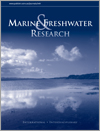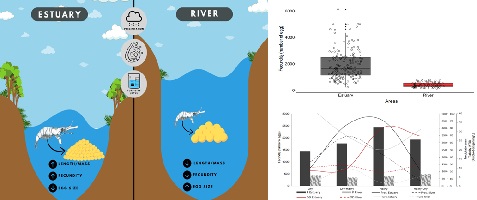In this study, we sought to determine which abiotic factors influence the fecundity and size of populations of M. amazonicum in estuary and river environments. Precipitation, turbidity and dissolved oxygen are determining factors for the differences found in the fecundity and size of M. amazonicum females in different environments. This information should be useful for improving the cost-efficiency of prawn culture. (Image credit: Breno Silva and Juan Caldas.)

Marine and Freshwater Research
Volume 75 Number 13 2024
The aim was to explore how environmental filters act on the diversity of periphytic algae in tropical aquatic ecosystems. In this study, we analysed how environmental filters act on the biodiversity of periphytic algae in a tropical reservoir. We discovered that physical and chemical filters directly influence the alpha and beta diversity of periphytic algae and the importance of the presence of aquatic macrophytes.
We described and quantified the fish assemblages at the heritage-listed Busselton Jetty, and made comparisons with natural reef, seagrass and sand habitats in Geographe Bay. The mean number of fish, species diversity and biomass all increased with distance along the jetty. The fish assemblage at the jetty was unique and different from that in all three natural habitats. Habitat complexity, depth and distance from shore were the key drivers of these differences.
MF24011 Abstract | MF24011 Full Text | MF24011PDF (900 KB) Open Access Article
Climate change affects marine environments, disrupting fisheries and ecosystems. Marine crustaceans, like swimming crabs in the Taiwan Strait, respond by altering catchability and habitat suitability. El Niño events significantly affect their fishing grounds, whereas water exchange and wind changes influence temperature, salinity and water mass structure. During La Niña years, positive ocean temperature and salinity anomalies may further affect the optimal habitats and catchability of swimming crabs.
The Great Artesian Basin (GAB) is Australia’s largest freshwater resource. Springs fed by the GAB support many species not found elsewhere on Earth, but conservation is hindered by a lack of fundamental knowledge about the plants, animals and fungi reliant on these habitats. Using South Australia as a case study, we provide a comprehensive review of GAB biodiversity in that state.
MF24118 Abstract | MF24118 Full Text | MF24118PDF (1.6 MB) Open Access Article





